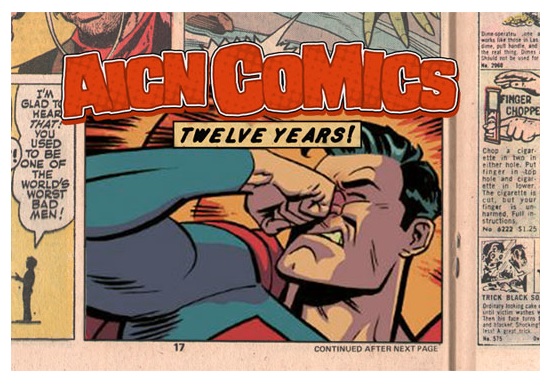
(Click title to go directly to the review)
Advance Review: BATMAN ’66 #1
THE SHADOW/GREEN HORNET: DARK NIGHTS #1
Indie Jones presents SUPERMAG #1
DAREDEVIL #28
Indie Jones presents MARCH BOOK ONE
QUANTUM & WOODY #1
Indie Jones presents NIGHT OF THE 80’s UNDEAD #1
GHOSTED #1
Indie Jones presents THE LEGEND OF OZ: THE WICKED WEST VOL.1
SUPERIOR SPIDER-MAN #13
Indie Jones presents COPRA #7
JUSTICE LEAGUE #22
Indie Jones presents ORDER & CHAOS #1
 Advance Review: In stores today!
Advance Review: In stores today!BATMAN ‘66 #1
Writer: Jeff ParkerArtist: Jonathan Case
Publisher: DC Comics
Reviewer: Optimous Douche
Come back with me for a second to a time when McCarthy-era sensibilities had yet to be smoked out by the “Age of Aquarius.” A time when virtue was coveted as opposed to ridiculed, and a time when the good guys would always save the day despite the most harrowing of cliffhangers. BATMAN ‘66 is a perfect homage to a world where campy was the bedrock of television programming, and the dynamic duo had yet to be run through the proverbial wringer of societal cynicism.
I grew up in the dark age of comics, so to take any of BATMAN ‘66 seriously is a near impossibility. However, I can fully appreciate the spirit from whence it came. Just because it’s not my book shouldn’t negate the fact there is still a ton of fans that desperately thirst for heroes who skip the anti hyphen and always save the day.
There isn’t one element of the original TV series’ themes that haven’t made it into ’66. A boy wonder that is more acrobatic than academic, a PSA interspersed between puns and an honest to God beginning middle and end are all awaiting Batfans on Batchannel One. Adam West always had a bit of a condescending delivery, and as an adult I now realize it’s because Burt Ward was about as smart as a real Robin. Parker pulls no punches in this talking down, but it never becomes jokey. BATMAN ’66 is truly authentic, with a small dash of hindsight thrown in for even more fun.
The plot is almost incidental to the experience of BATMAN ’66. The Riddler has stolen a precious statue called The Lady of Gotham, one of 3 golden statues crafted to commemorate something or other. Again, it doesn’t matter, because what nostalgia makes you wait for is the chapter break alliteration, the horrific puns that only an actor like Burt Ward could deliver with sincerity and the overly heavy gravitas Adam West would deliver in every line whether he was delivering a morality lesson about crime or talking about the importance of fire extinguishers. I would love to get a teenager’s take on this book. On one hand, the child in me sees all this as talking down, while the man who is going to be a father thinks that maybe we’ve given up on our kids and we actually should explain the world to them in a bit more detail.
Frank Gorshin isn’t the only villain to make an appearance in this tale; we also get a few moments with super keen cat-suit clad Julie Newmar, a woman who still exudes sex despite the fact she hit menopause when Nixon was in office. Case was very careful with these characters; while they all bear a striking resemblance to their small screen counterparts, none are so hyper-detailed that it crosses into the often stilted likenesses that plague licensed properties. Also, there’s absolutely no apologies in using the Silver Age trope of jumping from one harrowing scene to the next with little explanation. This is a compliment, believe it or not. We often fault Morrison for this tactic, but we forget a time when a bomb would go up and we wouldn’t learn how the heroes escaped until tomorrow’s action packed episode. There’s no freaking way any of it is plausible, but the explanation’s deep complexity just makes you roll with it.
Again, these new stories won’t be for every comic collector, but for anyone who laments the current morose state of heroics, salvation awaits you each month at the same Bat-time in the same Bat-comic shop.
Optimous Douche has successfully blackmailed BottleImp to draw purty pictures for his graphic novel AVERAGE JOE coming out in 2013 from COM.X. When not on Ain’t It Cool, Optimous can be found talking comics and marketing on robpatey.com and just marketing on MaaS360.com.
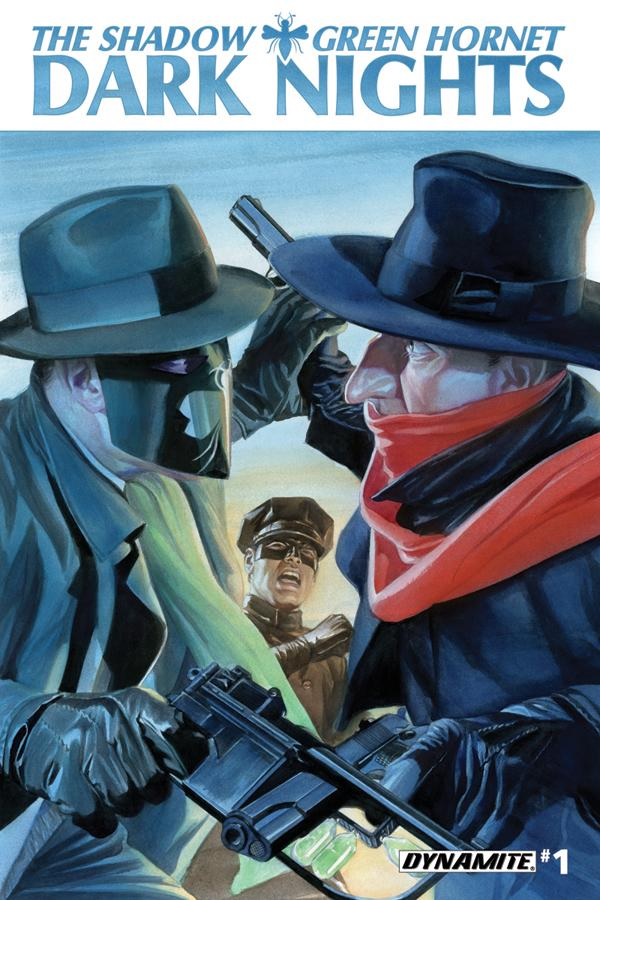
THE SHADOW/GREEN HORNET: DARK NIGHTS #1
Writer: Michael UslanArtist: Keith Burns
Publisher: Dynamite Entertainment
Reviewer: Corey Michael Dalton
As someone with not much more than a passing knowledge of The Shadow and The Green Hornet, I was intrigued to see that Dynamite was putting out a 5-issue miniseries teaming up the two pulp crime fighters. Scanning the house ads in this issue, though, it appears that Dynamite has created its own cottage industry publishing characters like these in titles such as MASKS (starring both of these guys plus Kato, The Spider, and others), KINGS WATCH (The Phantom, Flash Gordon, and Mandrake the Magician), CODENAME: ACTION (Captain Action, Operator No. 5, and Black Venus), SHADOW: YEAR ONE, and BLACK BAT. Where have I been?
But back to the issue at hand! How was THE SHADOW/GREEN HORNET: DARK NIGHTS #1? Pretty dang enjoyable, actually! Uslan (primarily known as the producer of the Batman movies, although he's also written quite a few comics, including the headline-grabbing ARCHIE MARRIES VERONICA/ARCHIE MARRIES BETTY) opens the comic with an extended prologue set in 1920. In this section, Kent Allard, the man who will one day be The Shadow, appears at the White House bearing ill news: he has discovered that the true force behind World War I was a power-mad descendent of Genghis Khan called Shiwan Khan. After Allard assures the de facto President of the United States, Edith Wilson, that he managed to secure something called the girasol to keep it out of Khan's hands, he heads off to the Orient to learn to harness his mind powers and to control the girasol. Essentially, this section of the comic reveals the secret origin of The Shadow, beginning when he was America's best spy working under the codename The Dark Eagle and ending with him on a collision course with his Shadow-y destiny. I don't know if all this origin stuff will be redundant to fans of The Shadow, but as a relative newbie to the character, I was fascinated.
The only real issue I had with this section was the introduction of the MacGuffin, the girasol. Maybe I'm out of touch with my gemstones, but I had no idea what a girasol was (apparently it's a reddish opal.) Nor do I really understand why this particular girasol is so important as a mystical artifact. Allard and Wilson talk about the thing as if we (the audience) already know all about it. It would have been nice if the dialogue or art had clarified right up front what they were discussing so the non-jewelers among us wouldn't be confused. Still, I did learn some gemology, I suppose. And I learned some actual history as well; I was not aware that Woodrow Wilson's wife had (arguably) become a kind of shadow president after her husband's stroke in 1919. See, teachers? Comics can be educational.
When Kent Allard reappears in the next segment of the comic (set in 1939), he is calling himself Lamont Cranston, the rich playboy who is secretly The Shadow. At a meeting of capitalist leaders hosted by none other than Franklin Delano Roosevelt, Cranston is introduced to Britt Reid, a newspaper publisher who moonlights as the supposedly-bad-but-really-good Green Hornet. FDR explains that a second world war is on the horizon, and asks his guests to help him secretly prepare for it. During the conversation the president casually mentions to Reid that he once met his uncle, The Lone Ranger. I had no idea they were related! Masks must be hereditary. Later, while Britt and Lamont take their female assistants on a double date (who somehow know and dislike each other), Hitler is busy conferring with the man behind his newfound power—Shiwan Khan, who is still searching for the girasol. This dude really likes causing world wars--and flashy jewels. Khan plans to force Cranston to retrieve the gem from Nikola Tesla (yeah, he's in this comic, too) and then use it, which will somehow allow Shiwan to gain control of it. But how can he threaten Tesla and make Cranston use the girasol? He decides to hire The Green Hornet to attack Tesla, of course! And… scene.
THE SHADOW/GREEN HORNET: DARK NIGHTS #1 is a good start to what should be a fun miniseries. It was a bit talky, but it is setting up the plot for the remaining four issues, so that's to be expected. Sometimes the dialogue seemed stilted and expository, but not to such an extent that it distracted me from the story. And for a comic touting two pulp heroes in its title, it is a little odd that neither one ever actually suited up in the issue (although The Green Hornet did make a one-panel appearance in a flashback).
I've never heard of artist Keith Burns, but his talent is evident. He provides angular, shadowy art that harkens back to the characters' pulp roots and reminded me a bit of Guy Davis's art for SANDMAN MYSTERY THEATER. The muted colors by Tony Aviña also support this film noir-like tone. Burns throws in some interesting panel compositions as well, such as one showing Edith Wilson through the lens of her husband's glasses, the president's unresponsive eye highlighted in the extreme foreground. There were a few storytelling problems, though. For example, the art is not clear at the bottom of first page and top of second. I couldn't decide if the White House guards let Allard through the gates because they recognized his name or because he showed them his wounds beneath his scarf. I just couldn't tell what was going on. The dialogue later seems to suggest that his physical deformities convinced the guards to let him pass, but I'm not sure why/how that would have worked.
If Uslan can make good on the promise of this first issue, we should have a solid miniseries on our hands here. Let's just hope that the two lead crimefighters actually get to put in an appearance (or two) next time!
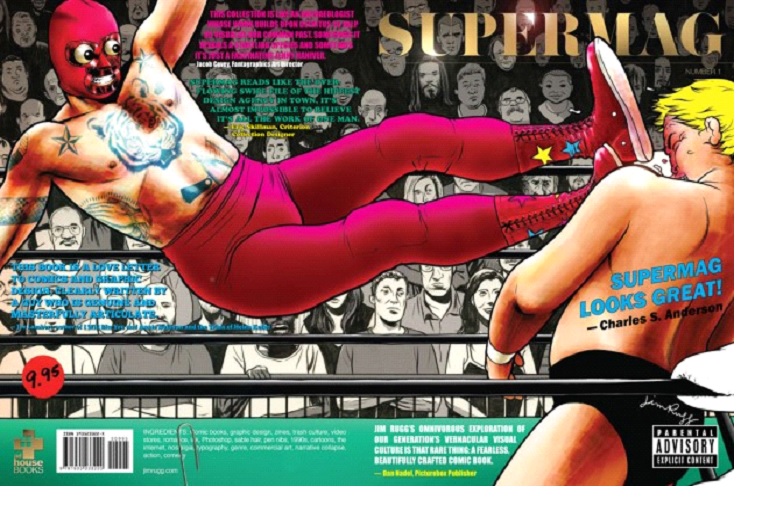

SUPERMAG #1
Writer/Artist: Jim RuggPublisher: AdHouse Books
Reviewer: MajinFu
Note: This comic was originally released weeks ago, but your lovable Fu is just getting to it because my masochistic nature dictates I traipse through every other mediocre project before allowing myself to get to the good stuff.
Amaze-balls. There, SUPERMAG--if you were looking for blurbs for the next cover, that one’s on the house. Simply amaze-balls.
I picked up SUPERMAG #1 after spotting the cover on the rack of a local shop, flipped through its pages and promptly put it back. It was like looking into the Ark, and I was afraid my face skin was about to burn off, like this book looked so good it couldn’t be trusted. It was also $10, and my poor ass couldn’t stomach such a purchase, but that’s neither here nor there. Finally deciding SUPERMAG #1 would not become become my Great White Buffalo, I picked it up on my next visit (shout out to Floating World Comics for saving me a copy, and just being a damn fine facility in general), a decision I am now here to celebrate.
“Narrative collapse” is a phrase that gets tossed around quite a lot in this book, an apt description for what you’ll find here: various stories, design ventures and pinups illustrated in a staggering array of styles, hardly ever containing much of a conclusive story. Although several stories contain storytelling contributions from others, Jim Rugg is the star here, and this magazine is as much a portfolio as an anthology, shifting rapidly from one creation to another. It’s jarring in the best possible way, compelling without committing to any singular vision.
Reading a magazine like flipping channels on a television was refreshing, while subverting many of my expectations pertaining to graphic storytelling. SUPERMAG gives you everything from U.S. APE battling the likes of Kim Jong-Il, the Iron Sheik, and Osama Bin-Laden sporting an uber-brain to Kafkaesque eroticism, surreal visions of apocalyptic scenarios, and even a little porn-theater memoir. You’ll find little introspective moments sandwiched between pulpy references, earnest romance next to ambivalent sex, and many, many sincere appraisals of what you might consider contemporary masculinity.
Although lacking in titles or context, many of the single page comics prove to be some of the most compelling, mostly because the verve of the more visceral comics had been replaced with sincere emotional depth, the fleeting nature of the prose making the story more actualized. One of the best pages simply portrays various masked facades spouting quotations on truth, while another shows a couple earnestly discussing their future plans. These single pages are more about a feeling than a full story, and each one left me craving more.
(The sub-title “NUMBER 1” seems to imply additional content is on the way. We can only hope as insatiable consumers of cool crap that this is the case.)
If you’re at all concerned for the literary nutrition of such a project, simply consult a list of “ingredients” contained on the back cover including “trash culture,” “sable hair,” “1990s, cartoons, the internet, nostalgia, typography,” “action” and “comedy.” If you like any of the things listed above, if you need an additional dose of machismo in your day, you need to check this book out. Don’t delay and regret the time spent apart like I did; just go. Now!
Ok, if you’re still looking for more reasons to drop a dime and spend the time with one of this year’s biggest graphical triumphs, consider the children. Do you really want them reading another questionable comic where Superman and Batman mistake each other for scoundrels (again), or would you rather give them a Tom and Jerry lampoon where the mouse’s cousin is realistically made an example of natural selection? …don’t answer that.
There’s more to this zine than brutalized anthropomorphs, ephemeral romance and allusions to action movies. The second page is essentially an ad for www.healthyartists.org by way of a diagram depicting the interior of the human body on a doll, effectively informing the readers of a meaningful cause while showcasing Rugg’s practical design sense. I love when comics take the time to enlighten readers about topics relevant to their actual lives, and this was a prime example of how to execute such an endeavor the right way.
SUPERMAG NUMBER 1 is awesome, and not just because that cover seems to be personally pandering to my wrestling fetish. This is an incredible display of a single artist’s versatility and easily ranks as one of the most pleasurable reads of the year. Congratulations to Jim Rugg, and thank you on behalf of anyone with a pulse and the good sense to pick up this brilliant work of creative potency.
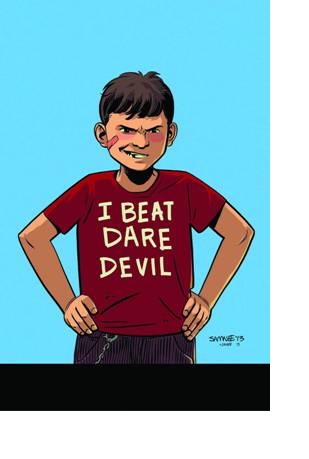
DAREDEVIL #28
Writer: Mark WaidArtist: Javier Rodriguez
Publisher: Marvel Comics
Reviewer: Masked Man
I gotta say, Waid does a pretty good job of taking something that looks like a standalone issue, and turning it into the next big story arc. Look at this cover, read a few pages. This is just a time-out issue, right? Filler, standalone--check the last page. No, there is something more going on here! At the risk of sounding like a broken record, Waid is truly a great storyteller, and he proves it with Daredevil over and over again.
Lots of old school readers, like myself, enjoy Waid's writing simply for the fact that he knows the history of these characters and uses it. Sure, he may play with the formula, showing the characters in a new light, but he does it from a point of character exploration as opposed to just ignoring a character's history because it doesn't fit the story he wants to tell. In this issue Waid reaches way, way, way back into Daredevil's past to find an old adversary of his, who has now come looking for his help in court. Spoiler time--but seriously, look at the cover. Who is this old adversary? His elementary school bully. Waid does a really nice job showing each character's take on the past. The bully, knowing he did wrong, still believes he was kinda justified. Murdock, of course, decides he must be the better man and help his old 'friend'. That's when Waid throws a huge curve ball, which I won't spoil, but will make you want to read the next issue so you can find out how deep Matt and his 'old buddy' have gotten themselves into it.
Javier Rodriguez steps in as the fill-in artist for this issue and he does a good job with it. He continues to keep the pages clean and simple, with interesting storytelling, something Paolo Rivera shaped-up back in issue number one. While Daredevil himself doesn't get much screen time, Rodriguez does a fine job drawing Matt Murdock's world. From Foggy's hospital bed, to the court room, to the New York skyline, everything is well done and fits the tone of the story.
Lastly, I got to say after 28 issues is this easily my longest stretch with DAREDEVIL. I've always been a passing fan of the character since seeing reprints of Wally Wood’s issues, way back when. I missed the classic Frank Miller run because I was a DC zombie at the time. I'm not much of a grim/gritty/realistic superhero fan, so I didn't get into the Marvel Knights run either, though I never understood how Daredevil was the only major Marvel hero (from the Silver Age) who never got a cartoon show while I was growing up and to this day (maybe TV execs think a lawyer would bore kids!) That said, I'm glad that Mark Waid has managed to get DAREDEVIL to make a dent in my long box in between Ennis's DAN DARE and Moench's BATMAN LEGENDS OF THE DARK KNIGHT (yeah, I store it under 'D'). I didn't even pick it up for Waid; I just wanted to give old hornhead another shot with the new number one. Two years later, Waid still has me reading, and that's impressive in my book.
Learn more about the Masked Man and feel free check out his comic book CINDY LI: THREE OF A KIND and CAPAIN ROCKET at www.Toonocity.com
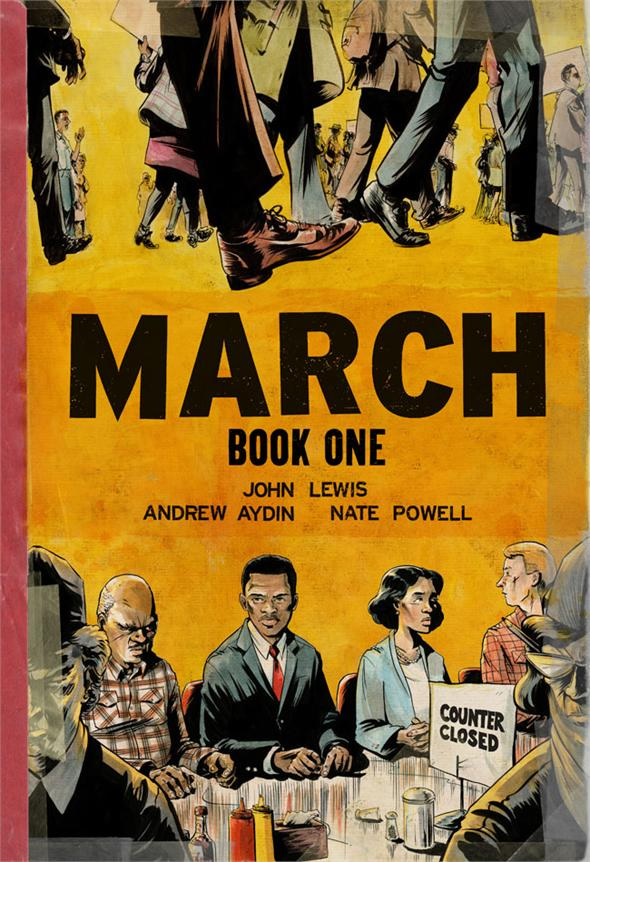

MARCH BOOK ONE
Writer: John Lewis and Andrew AydinArtist: Nate Powell
Publisher: Top Shelf Productions
Reviewer: The Dean
I’m a sucker for biographies. There are an infinite amount of ways to live life, and listening to or reading the stories of others is the closest we can ever get to experiencing what we might never be able to otherwise. I also hate people who talk too much about themselves, so…anyway, Congressman John Lewis has had, and continues to live, one of those lives that sounds like something Abe Simpson made up, except with MARCH it’s like that “Flying Hellfish” episode and everything he’s said turns out to be true. A great life doesn’t necessarily make a great comic, though, so Lewis enlists the help of Andrew Aydin and Nate Powell to help break his story into panels and word balloons.
MARCH is told mostly through the narration of Lewis as he recounts his incredible life to two children and their mother who’ve come by his office on the day of President Obama’s first inauguration. A device like this for what amounts to a history of the civil rights movement might be a tad on the nose for some, but for an all ages book, it’s a brief and effective “gather ‘round” moment that eases us into Lewis’ tale. It’s also a great contrast to the rather brutal opening scene at the Edmund Pettus Bridge, which gives us an idea of both the honesty and heart with which this story is being told.
This first book of the planned trilogy takes us through the Congressman’s upbringing in Alabama to his involvement in creating the Nashville Student Movement, including interactions with other notable leaders of the Civil Rights movement along the way. In what was one of my favorite moments of this first book, we learn that this graphic novel is Lewis’ attempt at emulating his hero Martin Luther King Jr., who in 1958 helped to produce a comic book called MARTIN LUTHER KING AND THE MONTGOMERY STORY. There’s some more fodder to fuel your argument for the legitimacy of comics!
But speaking of heroes, the unsung hero of this project is undoubtedly Nate Powell, who brings a real comic artistry to MARCH which could easily have turned into your typical Bluewater garbage in the hands of someone less capable. There’s a clear didactic goal in MARCH that can make it feel like a lecture on occasion, but the collaboration of Powell and Aydin made this a far more enjoyable reading experience than I was expecting, with the occasional flash of brilliance from Powell – the road trip Lewis takes from his rural Alabama home up to the Northern states is nothing short of a cartooning lesson that makes for a great short story on its own.
MARCH could easily have made Top Shelf a lot of money based on its author and premise alone, but fortunately Lewis, Aydin, and especially Powell make a pretty formidable creative team that have left me excited for book two. Lewis has a great story to tell, and he’s clearly surrounded by some pretty great talent to help him tell it, so while MARCH might have a few narrative lulls here and there, it’s ultimately a riveting history that makes exceptional use of the comic book form.
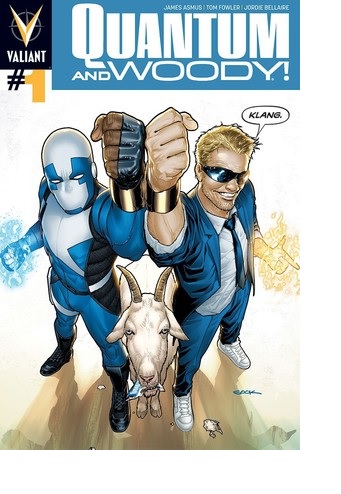
QUANTUM & WOODY #1
Writer: James AsmusArtist: Tom Fowler
Publisher: Valiant Entertainment
Reviewer: Optimous Douche
There’s a sect of fangeezers out there that have been on a quest for the better part of twenty years. Desperately we have traversed the comic book stands for what we affectionately once dubbed the Bwahaha. This seemingly nonsensical phrase refers to a time at DC Comics when the books were able to deliver an equal balance of humor along with emotionally weighty moments. Most of the Bwa came from JUSTICE LEAGUE INTERNATIONAL, the team that was manipulated together in a scheme begging for them to fail. They didn’t fail, they triumphed, and characters like Booster Gold and Blue Beetle kept us laughing until Doomsday cleaned Superman’s clock in 1992, at the same time making us believe that comics could have heart. We all thought there would be a chance for the Bwa to return when JLI launched post-New 52. Sadly it more blech than Bwa, and as such was one of the first titles to be voted off the island. Well, I am now here to herald the return of Bwa; it simply now resides over in Valiant’s QUANTUM & WOODY.
QUANTUM AND WOODY is the ultimate buddy comedy, an Odd Couple in spandex. These two brothers couldn’t be more polar opposites, and I say this without even acknowledging the fact that one is black and one is white. Now, while I won’t acknowledge this point, the book has no qualms in pointing out the Oreo on the shelf. In between jibes at Woody’s complete ineptitude and Quantum’s overly anal retentiveness there is a sprinkling of racial recognition, but Asmus never crosses any lines of good taste. In fact, at best their adopted nature is a footnote, but it is poetically delivered by the father of the pair in a flashback after his murder.
That’s right: QUANTUM & WOODY band together after years of estrangement to try and solve who killed their father, a scientist hell-bent on unlocking the secrets of the universe. Their estrangement is delivered in an interspersed style of flashbacks that really helped the book keep moving so there isn’t an ounce of heavily belabored exposition. From schoolyard fights vehemently protecting the other’s honor, to their teenage finding of self and ultimate separation of ways, Asmus always remembers the true love/hate of honest brotherhood. In fact, the two get their powers (whatever those might be) in a toddler-level scuffle to don a HAZMAT suit when they lock themselves inside their father’s particle thingamabobby. Being an only child, I’ve never understood this desire to man-wrestle for things, but I have enough cousins that ‘ve seen bloody noses delivered over who gets to hold the fucking Nintendo controller. Madness, but hilarious madness.
Despite my fervent lifelong love affair with all things Valiant, I missed QUANTUM & WOODY during valiant 1.0 in the 90s. I bailed on most titles after Shooter was shown the door, and by ‘96 all of my free money was being used to procure brick weed to seduce a bunch of Ani DeFranco fans (shhh--I still don’t believe they don’t like guys). Some of my contemporaries say this first issue lacked the bite of that series. Never having read it, I would be a charlatan to disagree. I will say after hearing some of the blatant racial jokes, though: times have changed, guys, and some of those jokes simply feel hackneyed in the context of society today. There are a shit ton more multicultural households today, and thankfully most of us have moved passed the idea that color versus environment defines the individual.
For me, Asmus and crew simply need to poke fun at the superhero genre like they did cover to cover on this book. Speaking of the covers, they are pretty spot-on about what’s inside the book. From the goat proclaiming “meh” to the cover where they slap bracelets and sarcastically battle cry the sound effect klang, this series is dryer than a new Maytag.
My only question, quandary and general cornfusion stems from how this integrates into the rest of the Valiant U. Valiant of yore and the current run set the bar for editorial excellence and communication across titles. Even before mini-events like the current HARBINGER WARS, Valiant would sprinkle small little morsels of other title happenings. QUANTUM & WOODY for now is completely off the reservation. From newscasters talking about superheroes to nary a word about a little stand-off that has shut down Las Vegas, these guys are islands in their own stream. That’s OK, I guess. I still naively believe books should serve a larger universal whole, but I don’t fault those that tell me my thinking is antiquated and just enjoy the damn story.
Make no mistake: I did enjoy QUANTUM & WOODY, thoroughly. Fowler draws action as adeptly as douchebaggery. Asmus is as funny as he is sincere. Plausible implausibility makes for some of the best comics, and in that regard QUANTUM & WOODY is bar none.
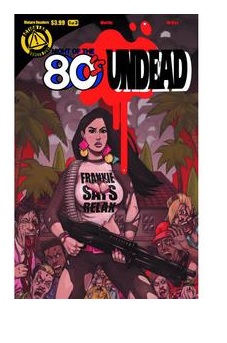

NIGHT OF THE 80’S UNDEAD #1
Writer: Jason MartinArtist: Bill McKay
Publisher: Action Lab Comics
Reviewer: Lyzard
NIGHT OF THE 80’S UNDEAD is one of those comics that has, like, totally tubular ideas. Though the book is stuffed with awesome concepts that alone are really rad, put ‘em together and they’re just bogus.
I mean, you got a bitchin’ take on zombies, a monster that I thought I’d have to gag myself with a spoon if forced to read another book on them. It’s 1986 and the Soviets (don’t you miss the days when the Russkies were always the villains?) have come up with a diabolical plan to contaminate high-end cocaine shipped via Columbia to the land of the rich and famous. If you thought crack was whack, wait till you see a bunch of Hollywood celebrities wiggin’ out on some nose candy that turns ‘em into grody coke-heads with a gnarly appetite for blow, blood, and brains.
< NIGHT OF THE 80’S intro is sure to get many Generation X-ers stoked, those wishing to reminiscence about days gone by or even some Millennials who think having watched a few John Hughes movies means they understand what the decade was like.
Think of NIGHT OF THE 80’S UNDEAD as “American Psycho” meets “Not Another Teen Movie”. You’ve got the violence and self-awareness of the Bret Easton Ellis novel, but then there is the excessive use of tropes and pop culture references of the spoof film. Like Ellis, writer Jason Martin puts way too much effort into creating the setting, filling the pages with numerous visual cues (aided by artist Bill McKay) followed by redundant side remarks that break the fourth wall. The commentary is dropped quickly, but replaced by dialogue that features more famous 80s quotes than original wording. The celebrity cameos work just the same: cool at first, but quickly becoming irritating due to their lack of unique jokes--except for a particular Scientologist who goes unnamed. NIGHT OF THE 80’S UNDEAD’s Xenu worshipper makes up for a crass and tasteless version of OJ Simpson and overly-perverted Schwarzenegger who just won’t shut up.
,br> Despite Martin’s flair for the extreme when it comes to his writing, he keeps his coloring to a minimal palette. The comic is mainly done in hues of teal, yellow, and hot pink for the backgrounds, a quick dose of the 80s without going overboard. McKay’s caricatures of the celebrities are spot on and the amount of gore was the only justifiable case for going over the top.
NIGHT OF THE 80’S UNDEAD tries all the traditional routes of harkening back to the past, and one model that may one day be effective. Included with the comic is a playlist with specified songs for specific pages. A Spotify link is provided so readers don’t have to hunt through their old mix tapes, burned CDs, or YouTube to find the songs. There’s nothing wrong with the playlist itself. All of the songs fit within their particular context, like Grandmaster Flash’s “White Lines” and Devo’s “Uncontrollable Urge”. The idea of creating a soundtrack to play along while reading the comic is inventive, but not executed properly. I don’t want to have to constantly refer back to the listings to find out what page I’m supposed to play what song. Sometimes the comic reminds you when to change, but I stopped trying to keep up after the first three songs (there are 9 total, most of which you need to change after three pages).
So there you have it. NIGHT OF THE 80’S UNDEAD takes a rad plot, throws in some righteous visuals, but just can’t stop with the post-modern parodying. Martin and McKay needed to take a chill pill and stop pushing everything to the max.
Lyzard is Lyz Reblin, a graduate student at the University of Texas pursuing a master's degree in Media Studies... which is just a fancy way of saying she plays a lot video games, watches far too many horror films, and then tries to pass it all off as "research."
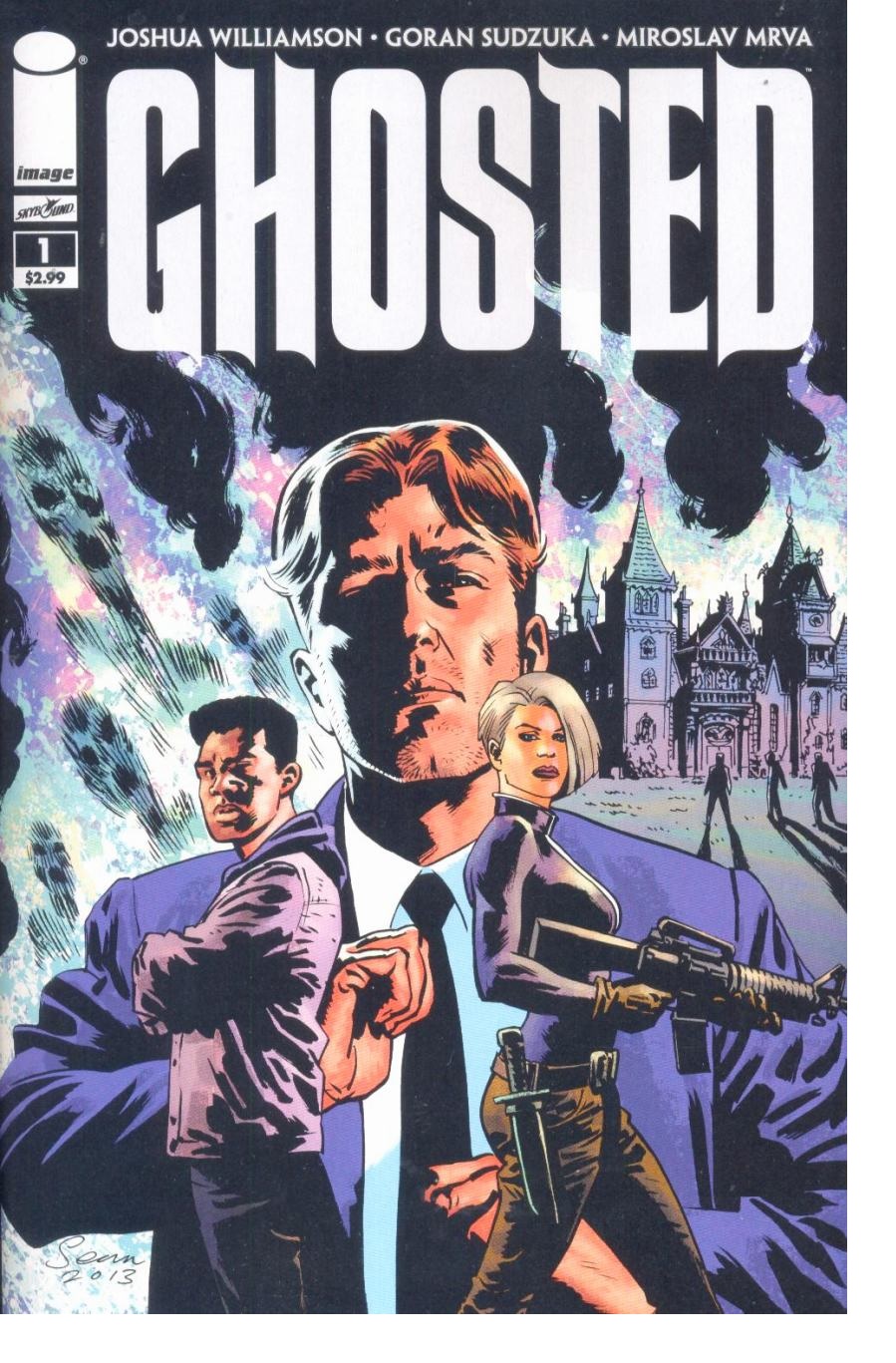
GHOSTED #1
Writer: Joshua WilliamsonArtist: Goran Sudzuka
Publisher: Image Comics
Reviewer: Humphrey Lee
We all love a good heist story, do we not? It’s the innate thrill, I feel, of rooting for the scoundrel that really keeps those stories kinetic. There’s multiple variations on the tale and the scoundrel, of course; some are a “thief with a moral code” or there’s the “revenge on the worse criminal approach” or there’s just fun in watching a charismatic kind of a bastard trying to save his own skin. Combine that with “the crew,” the gathering of roundabouts that will assist your lead scoundrel on his or her mission and these stories really make themselves by the cavalcade of personalities and motivations bandying about within. GHOSTED really lends itself well to the first couple of these tropes with a dirty yet magnetic lead, and by one-upping the heist stakes with its supernatural slant, but unfortunately the crew that should be rounding out this ghostly caper may as well be ethereal given their presence in this debut issue.
GHOSTED really does start off fantastically, though. By fantastically I mean “with prison butt rape and shower shivings”, but the attitude it sets forward by surrounding our protagonist, Winters, in such a brutal setting commentary tracked with a pretty aloof monologue by him. Nothing says intriguing like your lead casually ranting about prison food being the worst thing he deals with in a day while the calming sounds of forced butt pounding and sharpened spoons sliding through flesh surround him. These sounds make way to the beat of a “ratta-tat-tat” as we move into the caper itself after Anderson Lake – sexiness in a tight bodysuit and brandishing a pair of submachine guns – busts Winters out of jail and brings him to his new employer. I really have to say, I love the way the first half of this book plays out. Winters and his humorous ruminations over his situation, his immediate banter with Anderson once he’s in her and her boss’s grasp, and Winters’ attitude toward the old man who wants him to wrangle a ghost while also roiling up some bad memories over a job gone terribly wrong for him and his crew. Once this plays out and it’s time to get a band together, I just feel the momentum really takes a hit.
This hit comes in the form of I just get nothing from this secondary cast of characters. The rounding up the gang montage that usually ends up being the next solid chunk of the build to the caper, and that I expected to be the entire second half of this first issue, actually ends up being roughly three pages, and instead of it being rife with all these quirky character moments or lots of “remember that time” moments between Winters and people he’s done jobs with before, there’s just a few internal monologue blocks of Winters describing what they do, and maybe a few lines of dialogue to give some semblance of an insight into these peoples’ personalities. I don’t want to sound like I’m pegging this approach for not being the typical approach to heist story development; I’m lost by this segment because it’s kind of boring and barely succeeds in attaching me at all to this new group of characters I assume I’m going to spend at least a few issues watching in action. And, to double down on my disclaimers, I’m not saying that Williamson won’t be doing some good work in future issues to get me attached to these characters as the ghost-capturing job continues. But after seeing a really solid first half of the book insofar as it threw us into a really well done introduction to Winters, and then quickly developed a rapport between him and Anderson that carries some great interactions between the two through the second half (including a great line that went “Y’know, every time you open your mouth…I get an erection” that I plan on using on the wife one day), the way the characters were handled in that latter half came off very flat, as did the second half of the issue overall, to be frank, as I am also not really sold on this crew as the ghostbusting type. I am never really given an indication that anyone here has any inclination how the hell they will go about this ghost trapping as they’re just a bunch of con men--“Ghost Hunters” types, an aged stage magician, and one medium who looks like she’ll be the bulk of their action plan since she’s the only one with a modicum of exposure to dealing with ghosts hands on. Basically, if I’m not sold on the crew, how am I supposed to be sold on the job and the story relating to it? Answer: I’m not, but I’m also willing to be proven wrong.
I really do love the first half of GHOSTED. I think Winters is a great lead in the vein of the handsome, wavy-haired rogue sort. I love the idea of a supernatural-oriented heist story. And I also think Goran Sudzuka’s art here if faaaaaantastic. It’s a clean and expressive art style I was first introduced to in the pages of OUTLAW NATION. I never saw it as a step down from and even saw it as a rival to Pia Guerra’s art on Y: THE LAST MAN when he filled in, and I love it here. Much of the personality I do derive from this book comes from the art and its tone. It’s great here, and will be great in upcoming issues too; of this I have no doubt. If the writing of the second issue and on of GHOSTED matches up with the first half of this debut, then my friends, we will have ourselves yet another winner of a comic from the Image line. And I quite frankly have the highest of hopes and expectations that this will be the case from the overall strength of the dialogue and art and so on that this will be the case once we get a few more pages of growth and expansion of characters and plot. Otherwise, when it comes to this book and my pull list, it will be just that: Ghosted. Cheers…
Humphrey Lee has been an avid comic book reader going on fifteen years now and a contributor to Ain't It Cool comics for quite a few as well. In fact, reading comics is about all he does in his free time and where all the money from his day job wages goes to - funding his comic book habit so he can talk about them to you, our loyal readers (lucky you). He's a bit of a social networking whore, so you can find him all over the Interwebs on sites like Twitter, The MySpaces, Facebookand a blog where he also mostly talks about comics with his free time because he hasn't the slightest semblance of a life. Sad but true, and he gladly encourages you to add, read, and comment as you will.
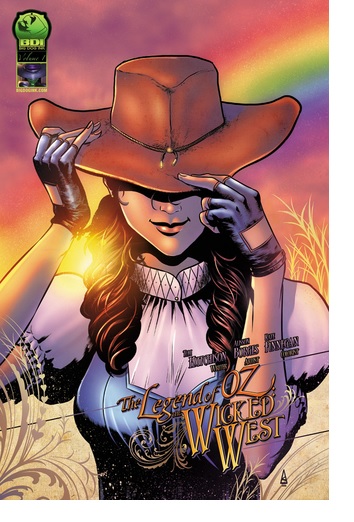

THE LEGEND OF OZ: THE WICKED WEST VOL . 1
Writer: Tom HutchisonArtist: Alisson Borges
Publisher: Big Dog Ink
Reviewer: Optimous Douche
Giddy up, munch-pokes, for the rootinest tootinest ride to OZ yet. Toto is now a shiny black steed, those fancified ruby slippers are now spurs and a host of other tumbleweed correlations await inside THE LEGEND OF OZ: THE WICKED WEST. Yes, we’ve been inundated with Baumbastic takes on Ms. Gale’s adventures over the past few years, and some have been less than stellar, but that’s the modern fate of public domain ideas. New interpretations, though, especially ones as original and gorgeously illustrated as this version, should not suffer for the folly of others.
I shouldn’t have to say this, but I feel I need to; you need to have a fondness for Oz if you’re going to imbibe Big Dog Ink’s take. Like Superman, if you hate the property I don’t believe any interpretation, no matter how good, will sway you to the positive. For me, Oz was my first foray into a lifelong love affair with musical theater. Before I could be trusted to sit all the way through a Broadway show, my mother and I would settle down each spring to watch “The Wizard of Oz” and “The Sound of Music” on TV. Flash forward to college, and I was one of those freaks from the theater department who enjoyed popping some magic mushrooms, kicking on the VCR, hitting mute and then cranking up Dark Side of the Moon on my state of the art CD player. Even with this affection, though, I’ll admit the only comic interpretation I have really enjoyed prior to THE WICKED WEST has been inside FABLES.
It’s a fine balance when you change or update such a beloved story. You need to be original, but not so original the transformation feels forced or unrecognizable. Despite my forced intro of Western slang, Big Dog Ink is guilty of no such crimes. All of the changes make sense and are combined in a compelling if albeit familiar story.
BDI has a branding challenge ahead of them. I discovered this title at this year’s Wizard World Philadelphia. They bought a very prominent booth right off the show floor’s main artery. The only trouble was that the gang was about 100 feet away from the only other comic company big presence table – Zenescope. On first blush, to say the two bear a striking resemblance is an understatement. They both have lush covers with lovely ladies on the front. They both imbibe horror and they both serve to empower not just the female form, but also the spirit. It also doesn’t help that Zenescope just released their own updated (but very different) take on Oz. Just to be above the board here, I don’t invoke Zenescope because I’ve written for them; I do this to serve the people.
Now, I will say if you have disliked Zenescope in the past that shouldn’t sway you from giving LEGEND OF OZ: THE WICKED WEST a chance. Unlike Zenescope, the quality of art continues all the way through this book from cover to special features. Zenescope tends to pull out all stops on the cover and then offers a frightful experience at times on the inside. I got lucky with my book, but not all can say the same. Borges’ talents shine on every page of this book, and while there are a few shots of Dorothy’s more supple parts, they are always covered in chaps or burlap and it’s no more egregious than any other comic on the market.
As for the story, to draw out all of the transformations from fantasy to Ol’ West would ruin the book. As I said, though, ruby slippers are now spurs and a set of six shooters that blast ruby bullets. The Scarecrow is no longer an idiotic man-child, but rather a silent squaw whose muteness is mistaken for mindlessness. I downright and absolutely refuse to illuminate the Tin Man since he was one of my favorite characters in the piece. However, fans of the Western genre can figure it out pretty quickly.
What I will say is that Hutchison did a great job skipping the fluff. Twister to the true arduous part of Dorothy’s journey is handled in a few short pages. No time is spent wasted in Munchkinland, though they are referenced a few times as the catalyst for Dorothy’s journey; likewise with the death of the West’s sister. We don’t see the barn take her out; we merely hear about it. Since I was reading a five issue trade these events might have happened in issue form, but I’m not certain. In my opinion these moments were fine to leave out for the compilation, though.
What I found almost equally as engaging as the characters was Oz itself. This wasn’t a three hour musical romp to find the Wizard and solve all problems. Dorothy has been in OZ for three years after she gets whisked away by the twister. In true Old West fashion, Oz is a desolate and barren land. The Yellow Brick Road is a piecemealed mess from people looting it. Like with the rest of Dorothy’s stops in her journey, this is a dusty and dirty Oz: an Oz a girl from the Midwest would really conjure as opposed to Hollywood’s sugar-coating of the experience.
I really enjoyed this book. It wasn’t earth-shattering or rife with deep thoughts, but the updating was original and the morality lessons enjoyable in Hutchison’s Old West voice. If you love Oz, get this book. If you only like Oz, I still think you’ll get a thrill since THE LEGEND OF OZ: THE WICKED WEST VOL. 1 is a very well-crafted comic book.
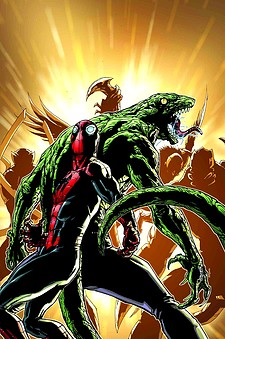
SUPERIOR SPIDER-MAN #13
Writer: Christos GageArt: Giuseppe Camuncoli
Publisher: Marvel Comics
Reviewer: Chris Massari
SUPERIOR SPIDER-MAN has been a series since the start that I’ve had mixed feelings about. Spider-Man is by far my favorite comic or fictional character of all time. So for Spider-Man not to be Peter Parker, it’s been a slight blow to the childhood in many fashions. I’m not against character development or even character death to change pace in storylines to keep them fresh. It’s just simple logic and necessity when writing fiction in order to keep things moving. So when Marvel decided to kill off Peter in the Ultimate universe to widen the story and introduce a more ethnically varied Spider-Man, I was completely cool with that. Peter got a respectable death, and Marvel introduced a hero-oriented character.
However, Marvel eliminating a character as big as Parker in Earth 616, their main universe of story, to add in someone as annoying and undeserving as Otto, it felt like a low blow to Spider-Man’s death (or not death, depending on whether Marvel retcons this or not). Also, the way Slott went about Peter’s apparent or not apparent death just left a bad taste in my mouth, and still does. I can’t completely knock the idea of SpOck (Otto Octavius Spider-Man). It’s definitely interesting, to say the least. But Slott’s whole method and writing surrounding the change still comes off as “let’s wow and piss people off so they buy our books”. Slott seems to constantly create plots to anger and upset readers to buy issues, rather than create character dynamics to push along a story. Personally, I have never been a fan of plot-pushed story because a good, deep storyline is driven by character, not wow factors in the plot, but I digress.
In SUPERIOR SPIDER-MAN #13 (written by Christos Gage, not Slott), we are met with the conclusion of the “The Raft” arc and the team up between J.J. Jameson and Spider-Ock against Alistair Smythe. Spider-Ock, instead of doing what a superhero would do, by racing to save the innocent people, SpOck does the Otto Octavius thing and goes after Smythe for a death battle (surprise, surprise). As Spider-Ock and Smythe duke it out, Jameson is having his own confrontation with Scorpion before being rescued by The Lizard, who seems to have Curt Connors’ consciousness in control once again. SpOck beats Smythe by killing him (surprise, surpise once again); this in turn shuts down all of the Spider Slayer-powered supervillains who were attacking everyone on The Raft there to watch Smythe’s execution. Without trying to spoil too much of the story for those who have not read it, some stuff happens with more surprises in the plot before Spider-Ock blackmails Jameson into giving him control of The Raft. Ock then orders some minions off eBay or online, I guess--I’m not really sure where one would make that purchase--ending the 13th issue of SUPERIOR SPIDER-MAN.
Positives of SUPERIOR SPIDER-MAN #13: Christos Gage’s scriptwriting is great and produced a good issue in that department. The writing definitely comes off as interesting. It continues to make me curious as to what direction the story will go, as far as his writing. Giuseppe Camuncoli’s penciling also comes off as one of the positives of the book. The way he draws the characters fits the whole idea of this Superior Spider-Man. The art of the entire series thus far has been pretty phenomenal; everything from coloring to shading, environment to character, I’ve really enjoyed the series’ artwork.
The negatives: if I haven’t already sarcastically suggested that I’m not a fan of Dan Slott enough yet, here’s one more time. I don’t like his plot. I just can’t get behind a story that’s driven by what can I do next that people will say “OMG why would he do that?” hash tag something angry. After Spidey-Ock killing Massacre, the entire plot leading up to Smythe’s death seemed predicable. As a reader at this point I just know Slott’s going to do something he thinks the reader thinks he shouldn’t. Unlike when George R. R. Martin writes a story, you just have no idea what’s coming next in the story, creating surprise and a strong emotional connection the entire plot and characters themselves. Spider-Man at this point has gone from hero to anti-villain to basically a villain who kind of does good things. If I wanted to read a supervillain book, then I’d read a supervillain book, but I’m reading Spider-Man and therefore I want a Spider-Man story. It’s like going to a bar, ordering a beer, and then getting water.
The storyline of SUPERIOR SPIDER-MAN isn’t awful; it’s actually quite fascinating and sometimes very good. However, it doesn’t fit the character of Spider-Man. I believe this story would have worked better by creating a brand new character rather than redefining an old one so radically and so far from what makes Spidey Spidey. I would have much preferred this darker Spider-Man in the SCARLET SPIDER series, rather than the main Spider-Man story. I don’t knock heroes killing villains; the old idea of good being either black or white is outdated and an overall weak philosophy. I think Spider-Man as Parker could have been reinvented slightly darker and more focused after the incident with Silver Sable instead of this drastic 180 that has been created. I know this has been a divided subject between comic geeks and gals and will continue to be, depending on the direction Marvel takes this. I hope that didn’t come off as ranty as I think it did.
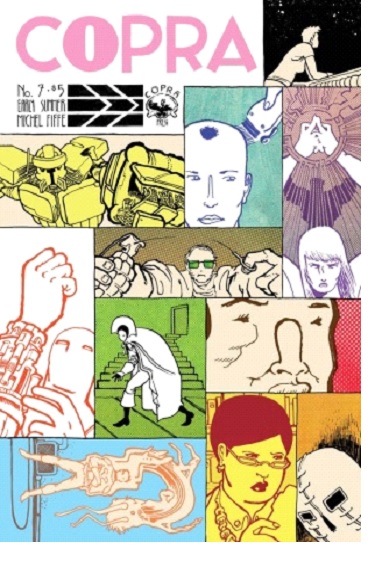

COPRA #7
Writer/Artist: Michel FiffePublisher: Copra Press
Reviewer: MajinFu
After the tragically brutal conclusion of COPRA #6, this issue’s reflective focus is a natural extension of the rogue team’s continued narrative, filled with character moments of the chaotic and quiet variety.
For those looking for an ‘in’ to the world of COPRA, this issue contains breakdowns of the entire cast, framed neatly around team leader Sonia’s extrapolations for each member of the rogue squadron. Every member gets at least one page of Sonia’s perceptions of their character, some kinder than others, all of them enlightening. Sonia is the perfect choice for the narrator, lending some impassioned context to each calculated description--oh and she strangles a guy in one of the most intense scenes to hit the page so far.
Michel Fiffe clearly got sick of everybody heaping praise upon COPRA for its tightly-choreographed action sequences and wanted to exhibit his knack for character work as well. Well played, sir. The emotional intensity coupled with geometrically precise layouts and bold visuals makes COPRA the most valuable “band of misfits” story in comics today.
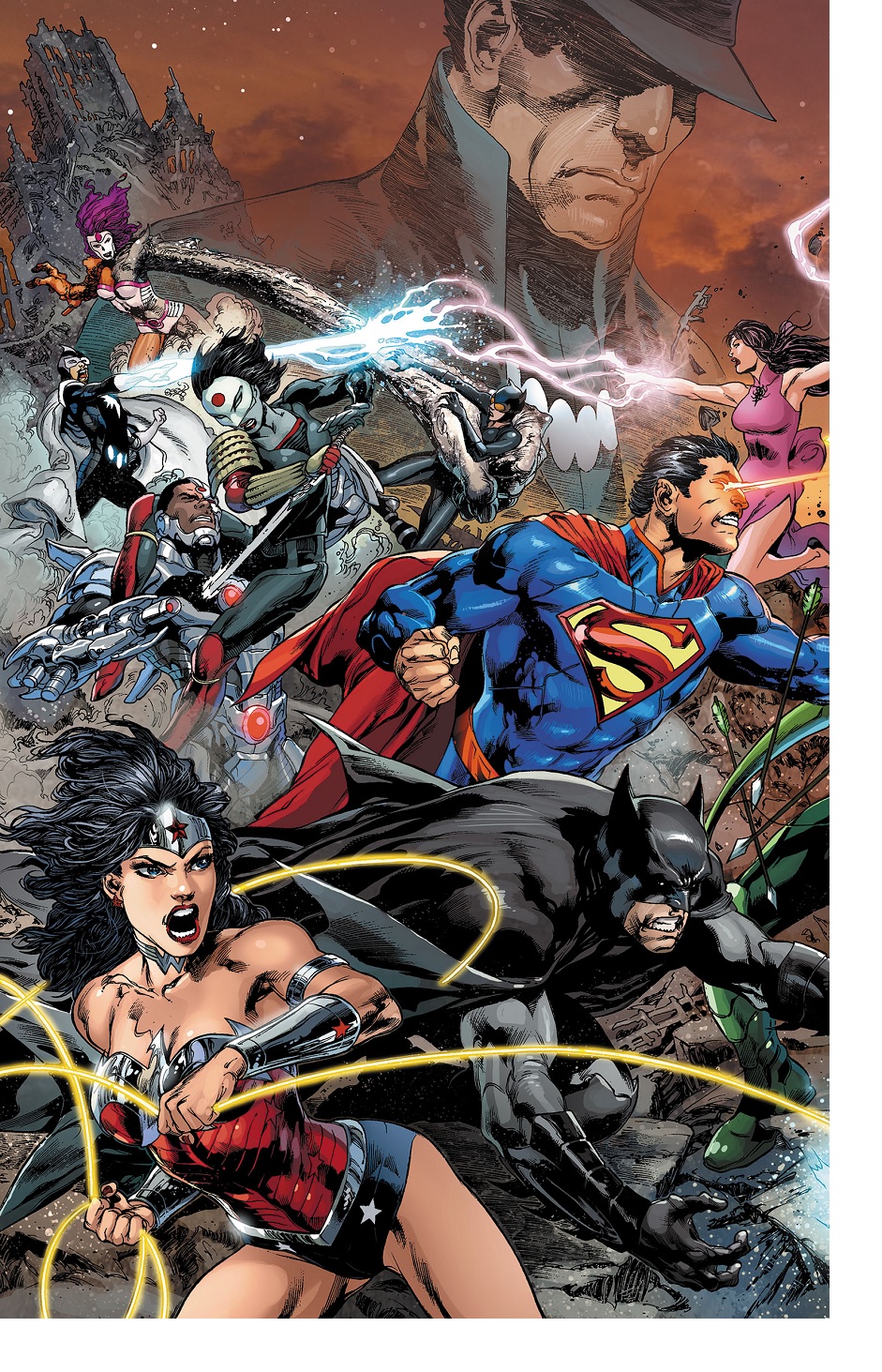
JUSTICE LEAGUE #22
Writer: Geoff JohnsArtist: Ivan Reis
Publisher: DC Comics
Reviewer: Masked Man
Well, after waiting nearly two years it's finally here: THE TRINITY WAR! And for all of us who haven't learned our lesson from AGE OF ULTRON, he we go with another major event crossover, though instead of just introducing a new character to the universe this one will apparently kill off the top superhero teams.
Right off the bat let's talk about what's good about this issue: the art! Holy H E double hockey sticks, Ivan Reis is on fire with this series. If anyone has a mad on to prove he's the best superhero artist in the business, it's Reis. I used to think Carlos Pacheco was the current king, but after Pacheco's less than stellar pages in AGE OF ULTRON and Reis' amazing pages here, Reis has taken the crown. Everyone he draws looks cool, all his action scenes are down right awesome, and his storytelling (which could get weak at times) is flawless. The short Shazam/Superman slugfest is easily the highlight of this issue. I cannot say enough good things about Reis' work here (kudos to Joe Prado, Oclair Albert and Rod Reis as well); this is nearly the only reason to buy the book, it's just so damn good looking.
Writing-wise, Johns does a good job of setting the stage and hitting hard with the action. There are a lot of moving parts to this story--JL, JLA, Pandora, Shazam, the Secret Society, and the Madame Xanadu bit (a little bit of JLD and SS)--and Johns blends them all together really well. He even does a fair job of touching on things that happened before this issue that have an impact on this issue, not that they are really important, but it's nice that he's working on tying things together (one of the things that made THRONE OF ATLANTIS a success). This is a really good start to an event book, which to a degree is what I think Johns is really good at: coming up with great ideas and setting up some really good superhero block buster fun. This issue is so much better than the first issue of AGE OF ULTRON.
Ok, I've told you that the art is amazing and I told you the story is good, but how do I feel about it? That's where I start to have a problem. This story still falls in the vein of the patent Johns storytelling technique of hiding the plot. Even with the weirdo twists of AGE OF ULTRON, I got the story: 'we are here to defeat Ultron anyway we can'. Here, I'm not really sure what's going on, which is odd since DC claims to have been building up to this story since NEW 52 day one, but aside from who's in it, I know about as much about it today as I did then. I'm still not even sure why it's called The Trinity War! Everyone believes it's the JL vs the JLA vs JLD angle. But if you remember when they announced it, there was no JLA, but there was a JLI, so was DC planning on canceling the JLI all along? I doubt it. Maybe Pandora, the Question and the Phantom Stranger are the Trinity at war. Madame Xanadu announces that 'they' are coming, and she needs to warn the JL--who are they? Are they the Trinity? Aside from watching superheroes fight each other, what is the point of this story? It's been nearly two years now, Johns--can you please tell me the plot? I feel like you are wasting my time with some kind of shell game.
Also, something that has bothered me since the start of the New 52: the Justice League is really dumb. Traditionally, the Justice League has been the smart superhero team. I believe it was Kurt Busiek who put it this way: “The Justice League is usually 'we need to figure this out' and The Avengers are usually, 'just pound the crap out of it'.” So to watch the League behave the way they do in the New 52 is annoying. I guess it makes the writing easier, because characters will do dumb things and get in trouble, like sending the whole JL to attack Shazam because he went to Kahndaq. Then the JLA shows up to get Justice League out of Kahndaq, but fail to ask Kahndaq for premission. And why does the Martian Manhunter have such a mad on against the JL? Furthermore, why do all DC women have to look like bikini models now? Waller, Xanadu…but I digress, I suppose.
So while this appears to be a good issue, overall I'm still not impressed with JL or New DC. Maybe my opinion will change when everyone's dead in September.
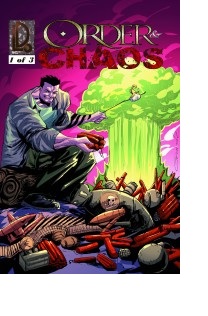

ORDER & CHAOS #1
Writer: Fred BoulosArtist: JC Grande
Publisher: Fred Boulos (Comixology Submit)
Reviewer: Optimous Douche
I’m no stranger to Comixology, despite my fangeezer love of all things tactile. I’m a realist who now spends enough time with toddlers to understand pulp is going the way of the dinosaurs. Yes, I still buy my weeklies, but I have started a counterbalance with digital to get myself ready for this brave new backlit frontier.
Not just any digital will do. Comixology has created the best experience on the Web for comic reading. PDFs were invented by a masochist, and I’m not quite the scumbag that I will as of yet .cbr torrent my collection. Morality aside, these are simply horrid ways to read a comic online. Zoom in to read the words, lose the panel. Zoom out to see the panel and bye-bye words. Only Comixology moves the panel like our eyes would across a page. Not to say Comixology is without flaws, but my grievance lies with the publishers more than Comixology. The fact we are charged the same price for something you never truly own outside of cloud storage is a little ridiculous. The price point gets more obscene when you think about all of the distribution that is shaved away in not having to physically put a comic on the shelf. However, unlike your local shop Comixology vastly discounts instead of raises the prices on older books, and now Comixology has released Submit. Submit is a kick in the nuts to Diamond’s ridiculous print count requirements and opens the way for all indie books, including ORDER & CHAOS, to get into the hands of fandom outside of conventions.
Sorry to spend so much word count on Submit, but I still feel this service needs more PR. I only pimp that which I believe in, and I would gladly serve as Comixology’s Huggy Bear given the purity of their mission to keep comics alive in the new digital frontier.
Now, I will say ORDER & CHAOS is not my first Submit review request. I’ve received others, and quite frankly they sucked. Sadly, they weren’t worth even the vastly discounted price. I won’t shit on indies, though; if a book has no chance of reaching the masses there’s no need to crush someone’s dreams. ORDER & CHAOS, though, this book is the goods. This could easily sit amongst the titles in the Image or Dark Horse lines.
The premise is simple: our protagonist loves destruction. We see early childhood days of him causing mayhem, from ripping apart Christmas presents to some slightly more nefarious misdemeanors. It’s not just about the destruction, though; it’s about the calculated precision required to truly obliterate something. Structural weakness, fracture points, chinks in the armor if you will. Mayhem is fine once in a while, but when you truly want to obliterate the physical world meticulous and methodical planning is essential.
Boulos does some fine work making destruction beautiful through our protagonist’s inner monologue. When our “hero” grows up he ends up where most kids that have a panache for destruction end up – the armed forces. His next step is logical as well; when you join the armed forces not out of patriotism or necessity, you go mercenary. This is where we spend the brunt of the book. Our man who finds order in chaos ends up selling his services to some middle eastern militants looking to stage a coup. I’ve never been a military guy, but I was truly fascinated as these battle plans unfolded. The juxtaposition of the holy war being fought by the rebels counterbalanced by our protagonist’s cavalier attitude towards anything but destruction made this first issue breeze by in moments. I will say some of the rebel dialog was a bit hackneyed, but I can also see the necessity given how much exposition was required to introduce the world. It probably was the only way to keep the story moving.
On the art side of things, I’ll best describe Grande as an indie comics Jeff Lemire. There’s a scratchiness to his pencils, but it’s not bred from laziness or lack of talent. It’s a choice and it works through 99% of the book. I’ll say his faces and form could use a bit more variety, but it’s a small flaw when compared to the well-drawn carnage.
ORDER & CHAOS is worth your time. Also, check out Submit – there’s gold in them thar indie hills if you simply look.
Proofs, co-edits & common sense provided by Sleazy G
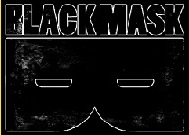 Find out what are BLACK MASK STUDIOS and OCCUPY COMICS here and on Facebook here!
Find out what are BLACK MASK STUDIOS and OCCUPY COMICS here and on Facebook here! Want more in all things Geek?
Want more in all things Geek?Check out PoptardsGo and on Facebook here!
 Get your copy of highly-anticipated anthology TOME by 44FLOOD here!
Get your copy of highly-anticipated anthology TOME by 44FLOOD here!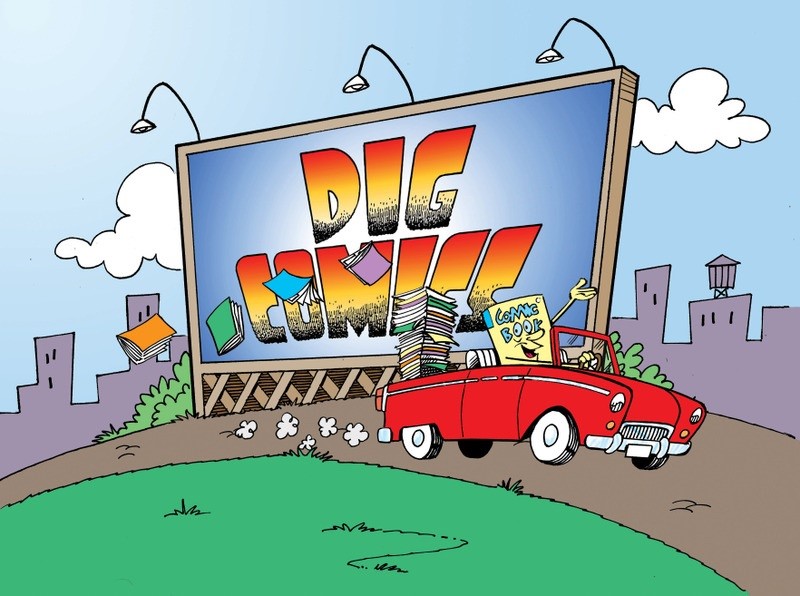 Love comics? So do the folks behind DIG COMICS! Support their Feature Film Kickstarter and share the love by clicking here!
Love comics? So do the folks behind DIG COMICS! Support their Feature Film Kickstarter and share the love by clicking here!Check out AICN COMICS on Facebook and Comixpedia.org!
